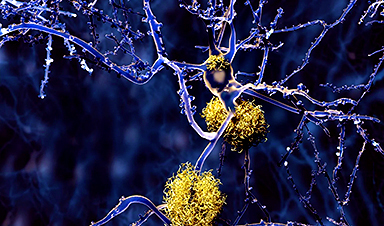Treating cancer with combinations of drugs can be more effective than using a single drug. However, figuring out the optimal combination of drugs, and making sure that all of the drugs reach the right place, can be challenging.
“There’s a lot of interest in finding synergistic combination therapies for cancer, meaning that they leverage some underlying mechanism of the cancer cell that allows them to kill more effectively, but oftentimes we don’t know what that right ratio will be,” says Jeremiah Johnson, an MIT professor of chemistry and one of the senior authors of the study.
In a study of mice, the researchers showed that nanoparticles carrying three drugs in the synergistic ratio they identified shrank tumors much more than when the three drugs were given at the same ratio but untethered to a particle. This nanoparticle platform could potentially be deployed to deliver drug combinations against a variety of cancers, the researchers say.
Irene Ghobrial, a professor of medicine at Harvard Medical School and Dana-Farber Cancer Institute, and P. Peter Ghoroghchian, president of Ceptur Therapeutics and a former MIT Koch Institute Clinical Investigator, are also senior authors of the paper, which appears today in Nature Nanotechnology. Alexandre Detappe, an assistant professor at the Strasbourg Europe Cancer Institute, and Hung Nguyen Ph.D. ’19 are the paper’s lead authors.
Controlled ratio
Using nanoparticles to deliver cancer drugs allows the drugs to accumulate at the tumor site and reduces toxic side effects because the particles protect the drugs from being released prematurely. However, only a handful of nanoparticle drug formulations have received FDA approval to treat cancer, and only one of these particles carries more than one drug.
For several years, Johnson’s lab has been working on polymer nanoparticles designed to carry multiple drugs. In the new study, the research team focused on a bottlebrush-shaped particle. To make the particles, drug molecules are inactivated by binding to polymer building blocks and then mixed together in a specific ratio for polymerization. This forms chains that extend from a central backbone, giving the molecule a bottlebrush-like structure with inactivated drugs—prodrugs—along the bottlebrush backbone. Cleavage of the linker that holds the drug to the backbone release the active agent.
“If we want to make a bottlebrush that has two drugs or three drugs or any number of drugs in it, we simply need to synthesize those different drug conjugated monomers, mix them together, and polymerize them. The resulting bottlebrushes have exactly the same size and shape as the bottlebrush that only has one drug, but now they have a distribution of two, three, or however many drugs you want within them,” Johnson says.
In this study, the researchers first tested particles carrying just one drug: bortezomib, which is used to treat multiple myeloma, a cancer that affects a type of B cells known as plasma cells. Bortezomib is a proteasome inhibitor, a type of drug that prevents cancer cells from breaking down the excess proteins they produce. Accumulation of these proteins eventually causes the tumor cells to die.
When bortezomib is given on its own, the drug tends accumulate in red blood cells, which have high proteasome concentrations. However, when the researchers gave their bottlebrush prodrug version of the drug to mice, they found that the particles accumulated primarily in plasma cells because the bottlebrush structure protects the drug from being released right away, allowing it to circulate long enough to reach its target.
Synergistic combinations
Using the bottlebrush particles, the researchers were also able to analyze many different drug combinations to evaluate which were the most effective.
Currently, researchers test potential drug combinations by exposing cancer cells in a lab dish to different concentrations of multiple drugs, but those results often don’t translate to patients because each drug is distributed and absorbed differently inside the human body.
“If you inject three drugs into the body, the likelihood that the correct ratio of those drugs will arrive at the cancer cell at the same time can be very low. The drugs have different properties that cause them to go to different places, and that hinders the translation of these identified synergistic drug ratios quite immensely,” Johnson says.
However, delivering all three drugs together in one particle could potentially overcome that obstacle and make it easier to deliver synergistic ratios. Because of the ease of creating bottlebrush particles with varying concentrations of drugs, the researchers were able to compare particles carrying different ratios of bortezomib and two other drugs used to treat multiple myeloma: an immunostimulatory drug called pomalidomide, and dexamethasone, an anti-inflammatory drug.
Exposing these particles to cancer cells in a lab dish revealed combinations that were synergistic, but these combinations were different from the synergistic ratios that had been identified using drugs not bound to the bottlebrush.
“What that tells us is that whenever you are trying to develop a synergistic drug combination that you ultimately plan to administer in a nanoparticle, you should measure synergy in the context of the nanoparticle,” Johnson says. “If you measure it for the drugs alone, and then try to make a nanoparticle with that ratio, you can’t guarantee it will be as effective.”
New combinations
In tests in two mouse models of multiple myeloma, the researchers found that three-drug bottlebrushes with a synergistic ratio significantly inhibited tumor growth compared to the free drugs given at the same ratio and to mixtures of three different single-drug bottlebrushes. They also discovered that their bortezomib-only bottlebrushes were very effective at slowing tumor growth when given in higher doses. Although it is approved for blood cancers such as multiple myeloma, bortezomib has never been approved for solid tumors due to its limited therapeutic window and bioavailability.
“We were happy to see that the bortezomib bottlebrush prodrug on its own was an excellent drug, displaying improved efficacy and safety compared to bortezomib, and that has led us to pursue trying to bring this molecule to the clinic as a next-generation proteasome inhibitor,” Johnson says. “It has completely different properties than bortezomib and gives you the ability to have a wider therapeutic index to treat cancers that bortezomib has not been used in before.”
Johnson, Nguyen, and Yivan Jiang Ph.D. ’19 have founded a company called Window Therapeutics, which is working on further developing these particles for testing in clinical trials. The company also hopes to explore other drug combinations that could be used against other types of cancer.
Johnson’s lab is also working on using these particles to deliver therapeutic antibodies along with drugs, as well as combining them with larger particles that could deliver messenger RNA along with drug molecules. “The versatility of this platform gives us endless opportunities to create new combinations,” he says.
News
Baffling Scientists for Centuries: New Study Unravels Mystery of Static Electricity
ISTA physicists demonstrate that contact electrification depends on the contact history of materials. For centuries, static electricity has intrigued and perplexed scientists. Now, researchers from the Waitukaitis group at the Institute of Science and [...]
Tumor “Stickiness” – Scientists Develop Potential New Way To Predict Cancer’s Spread
UC San Diego researchers have developed a device that predicts breast cancer aggressiveness by measuring tumor cell adhesion. Weakly adherent cells indicate a higher risk of metastasis, especially in early-stage DCIS. This innovation could [...]
Scientists Just Watched Atoms Move for the First Time Using AI
Scientists have developed a groundbreaking AI-driven technique that reveals the hidden movements of nanoparticles, essential in materials science, pharmaceuticals, and electronics. By integrating artificial intelligence with electron microscopy, researchers can now visualize atomic-level changes that were [...]
Scientists Sound Alarm: “Safe” Antibiotic Has Led to an Almost Untreatable Superbug
A recent study reveals that an antibiotic used for liver disease patients may increase their risk of contracting a dangerous superbug. An international team of researchers has discovered that rifaximin, a commonly prescribed antibiotic [...]
Scientists Discover Natural Compound That Stops Cancer Progression
A discovery led by OHSU was made possible by years of study conducted by University of Portland undergraduates. Scientists have discovered a natural compound that can halt a key process involved in the progression [...]
Scientists Just Discovered an RNA That Repairs DNA Damage – And It’s a Game-Changer
Our DNA is constantly under threat — from cell division errors to external factors like sunlight and smoking. Fortunately, cells have intricate repair mechanisms to counteract this damage. Scientists have uncovered a surprising role played by [...]
What Scientists Just Discovered About COVID-19’s Hidden Death Toll
COVID-19 didn’t just claim lives directly—it reshaped mortality patterns worldwide. A major international study found that life expectancy plummeted across most of the 24 analyzed countries, with additional deaths from cardiovascular disease, substance abuse, and mental [...]
Self-Propelled Nanoparticles Improve Immunotherapy for Non-Invasive Bladder Cancer
A study led by Pohang University of Science and Technology (POSTECH) and the Institute for Bioengineering of Catalonia (IBEC) in South Korea details the creation of urea-powered nanomotors that enhance immunotherapy for bladder cancer. The nanomotors [...]
Scientists Develop New System That Produces Drinking Water From Thin Air
UT Austin researchers have developed a biodegradable, biomass-based hydrogel that efficiently extracts drinkable water from the air, offering a scalable, sustainable solution for water access in off-grid communities, emergency relief, and agriculture. Discarded food [...]
AI Unveils Hidden Nanoparticles – A Breakthrough in Early Disease Detection
Deep Nanometry (DNM) is an innovative technique combining high-speed optical detection with AI-driven noise reduction, allowing researchers to find rare nanoparticles like extracellular vesicles (EVs). Since EVs play a role in disease detection, DNM [...]
Inhalable nanoparticles could help treat chronic lung disease
Nanoparticles designed to release antibiotics deep inside the lungs reduced inflammation and improved lung function in mice with symptoms of chronic obstructive pulmonary disease By Grace Wade Delivering medication to the lungs with inhalable nanoparticles [...]
New MRI Study Uncovers Hidden Lung Abnormalities in Children With Long COVID
Long COVID is more than just lingering symptoms—it may have a hidden biological basis that standard medical tests fail to detect. A groundbreaking study using advanced MRI technology has uncovered significant lung abnormalities in [...]
AI Struggles with Abstract Thought: Study Reveals GPT-4’s Limits
While GPT-4 performs well in structured reasoning tasks, a new study shows that its ability to adapt to variations is weak—suggesting AI still lacks true abstract understanding and flexibility in decision-making. Artificial Intelligence (AI), [...]
Turning Off Nerve Signals: Scientists Develop Promising New Pancreatic Cancer Treatment
Pancreatic cancer reprograms nerve cells to fuel its growth, but blocking these connections can shrink tumors and boost treatment effectiveness. Pancreatic cancer is closely linked to the nervous system, according to researchers from the [...]
New human antibody shows promise for Ebola virus treatment
New research led by scientists at La Jolla Institute for Immunology (LJI) reveals the workings of a human antibody called mAb 3A6, which may prove to be an important component for Ebola virus therapeutics. [...]
Early Alzheimer’s Detection Test – Years Before Symptoms Appear
A new biomarker test can detect early-stage tau protein clumping up to a decade before it appears on brain scans, improving early Alzheimer’s diagnosis. Unlike amyloid-beta, tau neurofibrillary tangles are directly linked to cognitive decline. Years [...]






















